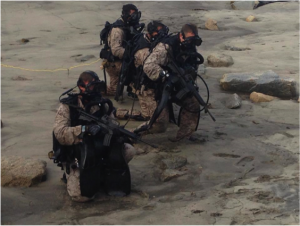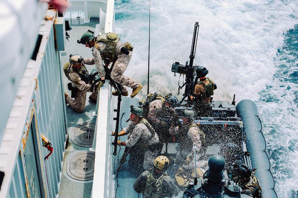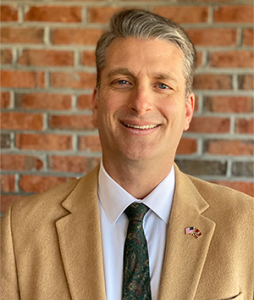by Carter Wilbur
The release of the National Security Strategy (NSS)[i] in 2017 and related National Defense Strategy (NDS)[ii] in 2018 shifted the United States’ strategic focus to what has become known as Great Power Competition (GPC). These strategies acknowledge that the almost 20-year long fight against violent extremist organizations (VEOs) will continue, but add the need to address emerging and enduring threats from near-peer competitors such as Russia and China, and those approaching that status, such as Iran and North Korea. To address these authoritarian competitors requires the seamless integration of all aspects of U.S. power. Specifically, this article seeks to examine the current status of the relationship between U.S. embassies and U.S. Special Operations Forces (USSOF), while Part 2 will propose some specific ways to improve that working relationship.

According to Congressional testimony in 2017 by then-U.S. Special Operations Commander Gen. Raymond Thomas, USSOF forces deployed to 149 countries that year. The USSOF relationship with the U.S. embassies in the countries where USSOF units deploy is generally good, but what worked in the counter-terrorism (CT) fight in the post-9/11 world is not the best approach to succeed in the great power competition we face now and in the future. This new look at threats from competitors like China and Russia presents an opportunity to reexamine and reimagine the USSOF-embassy relationship to make it an even stronger, more effective, and truly coordinated partnership.
While organizational differences between embassies and USSOF formations range from the degree of resources available to them (USSOF draws from the much larger DOD pool of resources) to the flatter structure of embassies compared to military hierarchies, both are working to achieve U.S. foreign policy and security objectives. Each organization brings its respective culture, tools, experiences, legal authorities, funding streams (with respective restrictions), levels of risk tolerance, and approaches to unique problem sets, but it is worth repeating that both are working to achieve the same top-level U.S. goals as set out in the National Security and Defense Strategies. Too often, however, these efforts are not as fully integrated as they could be. The reasons vary, but include an overly narrow mission focus, difficulties in communicating between organizations, and even organizational reluctances to fully share information. When deep integration between embassies and USSOF units is achieved, it is usually personality driven, often drawing from a civilian agency’s Foreign Service Officer who has a prior military service background, rather than from institutional level coordination[iii]. Working more closely together will help each organization achieve both its objectives and broader U.S. goals.
USSOF in Context

USSOF, by doctrine, has a role in each of the different phases of military operations, from peacetime preparations through armed conflict and on to reconstruction, but it has a unique role compared to conventional forces when it comes to operations prior to armed hostilities, such as shaping the battlefield prior to full-scale conflict, called Phase Zero operations by the U.S. military.[iv] USSOF efforts to influence an environment to favor U.S. interests in any future conflict against near-peer or great power interests should complement embassies’ work to promote U.S. bilateral, regional, and multilateral interests, and vice versa. However, too often embassy and USSOF efforts are parallel at best, without seeking out and exploiting potential synergies. For example, where a host nation faces severe internal challenges from violent extremists, partnering host nation military and security forces with USSOF is one of the clearest and most concrete ways to provide meaningful support, and a tool used today to advance U.S. security and stability goals in many such countries. To be fully effective, this USSOF effort must be wholly integrated with embassy efforts to establish good governance, social resilience, stability, and economic growth to reduce pressures contributing to recruitment by violent extremists. While this is happening today on an ad hoc basis at various embassies, both organizations can do more to coordinate their different means to achieve U.S. foreign policy goals. By extension, USSOF and embassy efforts must also move from the ad hoc to a whole-of-government approach in order to address fully the efforts by the United States’ near-peer competitors to achieve foreign policy goals that are contrary to U.S. interests around the world.
Foreign Service Officers who worked in Iraq, Afghanistan, and other high-threat or conflict posts during the peak years of 2004-2014 interacted, often daily, with U.S. military and specifically with USSOF counterparts. Newer Foreign Service Officers have had far fewer opportunities to interact with the U.S. military, much less with USSOF counterparts, on a routine basis. The same is also true on the military side; the embassy, consulate, and Provincial Reconstruction Team (PRT) touchpoints during the military and civilian surges exposed a wide swath of military personnel to the idea of working alongside State, USAID, and other interagency colleagues. They too have gone through cycles of promotion and attrition since then, leaving a whole new generation of company-level officers (lieutenants and captains) in USSOF who don’t have experiences of working with civilian foreign affairs officers. Both the civilian foreign affairs and USSOF communities must take conscious steps to maintain those lines of communication. In Part 2, I describe some thematic areas where civilian foreign affairs agencies and USSOF units can improve cooperation and find synergies of effort.
The United States’ competitors, such as Russia, China, North Korea, and Iran, are authoritarian regimes with a panoply of state-owned enterprises at their beck and call. Over the past 18 years, U.S. efforts worldwide have focused on counter terrorism, while the United States’ competitors described in the National Defense and National Security Strategies have used this time to pursue their foreign policy goals. With these competitors ready to use all the diplomatic, information, military, economic, financial, intelligence, and law enforcement[v] levers available to them, USSOF and U.S. embassies must do nothing less. This begins with a better understanding by both USSOF and embassies of each other’s missions, goals, and capabilities, leading to discussions of how they can each enable and support the other’s efforts in new and innovative ways.
In short, where USSOF is deployed in a host nation, the U.S. embassy should be talking to those USSOF formations to take advantage of their parallel efforts. This coordination should not just be an introductory office call when a USSOF unit enters the country, and not just with high-level command elements but with tactical-level units as well (of course, keeping their higher headquarters in the loop). For example, when a USSOF information operations section initially develops a product, such as a press release or social media post, it too often fails to communicate with an embassy’s Public Affairs Section (PAS), usually due to U.S. military control of who can talk to whom at the working level. The embassy is likely to see a finished USSOF product at a clearance stage, when any input a public affairs section could provide must flow back down through several levels of command. This often forces the embassy section to give a yes or no answer instead of helping USSOF develop a better product that reinforces other embassy programming by drawing on the expertise of local staff in terms of language, what messages resonate with local audiences, and tying into existing embassy messaging. A lack of advance coordination increases the risk of a ‘no’ answer as well. More communication between an embassy and USSOF units can head off potential problems or misunderstandings, or at a minimum catch them much earlier. USSOF brings unique tactical, communication, and medial capabilities to support an embassy in a crisis situation, and for security support in general, but communicating exactly how those USSOF capabilities can be used needs to happen earlier.
USSOF’s Evolution into a Future Force
USSOF is currently examining not only how it fights and wins on today’s battlefields but also how to evolve as a force to fight and win on future battlefields, especially in the context of adding the near-peer competitor threat to ongoing counter terrorism efforts. This creates an opportunity to reexamine the USSOF-embassy partnership and reshape it to take advantage of better integration throughout the U.S. government’s efforts. USSOF planners assume that future battle spaces will be more complex, crowded, and connected, requiring adjustments and recognizing that what worked against disjointed or loosely aligned terrorist groups in 2010 may not work against a near-peer state competitor in 2030. Likewise, evolving the USSOF–U.S. embassy relationship should be an ongoing and integral part of this future force development process. While there is little disagreement that a coordinated, whole-of-government approach is a good thing in principle, in practice, the failure to allocate sufficient resources to coordination efforts and the lack of understanding on both embassy and USSOF sides of the other’s mission, capabilities, and limitations are shortcomings which must be addressed. As examples, the Marine Corps Special Operations Forces (MARSOF) 2030 project[vi] at U.S. Marine Corps Forces Special Operations Command (MARSOC) lists “MARSOF as a Connector” among its four principal lines of effort, with the goal of bringing greater and more diverse capabilities together from across the U.S. government. The U.S. Army’s Special Operations Command (USASOC)[vii], the Air Force’s Special Operations Command (AFSOC), and the Naval Special Warfare Command (NAVSPECWAR) also have their own future force visions as well as the overarching vision from the umbrella command, Special Operations Command (SOCOM). The more deployed USSOF and the embassy understand each other’s respective missions and tailor their implementation to the overarching U.S. goals in that country, the more each can maximize its effectiveness in a whole of government approach and avoid leaving seams opponents can exploit. Beyond that, coordination between embassies and USSOF means being the best stewards of the American taxpayer’s money, getting the most for each dollar, whether it is budgeted to the Department of Defense, State Department, USAID, or other civilian agency.

Conclusion
An embassy represents the soft power arm of the U.S. government, while the conventional military is the epitome of hard power. USSOF sits between these as a “spikey soft power” with a small footprint, and often decentralized operations partnering with host nation forces, working to shape a particular foreign environment to favor U.S. objectives. As both embassies and USSOF shift to address more powerful and more unified competitors, communication between embassies and USSOF of their particular capabilities, objectives, and limitations will be more important than it was in the counter terrorism fight. Embassies and USSOF must develop a deeper mutual trust and awareness of what the other is doing and coordinate across the entire set of U.S. goals. The United States can and should be the worldwide partner of choice in security assistance, fostered through USSOF, conventional military, and the embassy’s Regional Security Officer and Law Enforcement programs, just as the United States can and should be the partner of choice in economic and governance affairs, through the embassies’ traditional political, economic, consular, public diplomacy, and development work. All U.S. foreign policy goals are interconnected, just as our efforts should be. In Part 2 of this article, I propose five specific thematic areas for both USSOF and embassies to more effectively achieve synergies towards overarching U.S. foreign policy objectives.![]()
I would like to thank Ambassadors Greta Holtz and Henry Ensher, fellow POLADs Linda Specht and Jan Levin, and Major Paul Bailey and Captain Tyler Kistner for their input into this project.

Carter Wilbur is a State Department Foreign Service Officer, currently serving as the Foreign Policy Advisor (POLAD) to the Commander, U.S. Marine Corps Forces Special Operations Command (MARSOC). The views expressed in this article are those of the author and are not an official policy or position of the Department of State or the U.S. Government.
Notes
[i] https://www.whitehouse.gov/wp-content/uploads/2017/12/NSS-Final-12-18-2017-0905.pdf
[ii] While the full NDS is a classified document, the Department of Defense has provided an unclassified summary to the public, available at https://dod.defense.gov/Portals/1/Documents/pubs/2018-National-Defense-Strategy-Summary.pdf.
[iii] In Washington D.C., as opposed to at the embassy level, the State Department’s Bureau of Political Military Affairs engages with a wide variety of U.S. military commands.
[iv] Joint Publication 3-0, Joint Operations, sets out six operational phases: Phase 0 (Shape), Phase 1 (Deter), Phase 2 (Seize the Initiative), Phase 3 (Dominate), Phase 4 (Stabilize), and Phase 5 (Enable Civil Authority).
https://www.jcs.mil/Portals/36/Documents/Doctrine/pubs/jp3_0ch1.pdf?ver=2018-11-27-160457-910
[v] The U.S. military uses the acronym DIMEFIL – Diplomatic, Information, Military, Economic, Financial, Intelligence, and Law Enforcement – to convey the broadest range of available instruments of national power.
[vi] MARSOF 2030: A Strategic Vision for the Future, March 2018, https://www.marsoc.marines.mil/Portals/31/Documents/MARSOF%202030.pdf?ver=2018-03-29-143631-557
[vii] USASOC 2035, https://www.soc.mil/SWCS/SWmag/archive/SW3003/USASOC%202035.pdf
